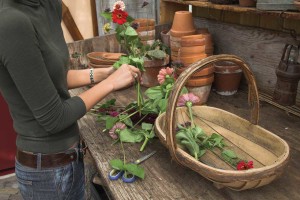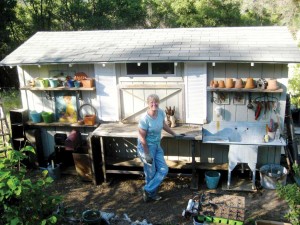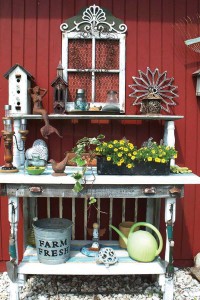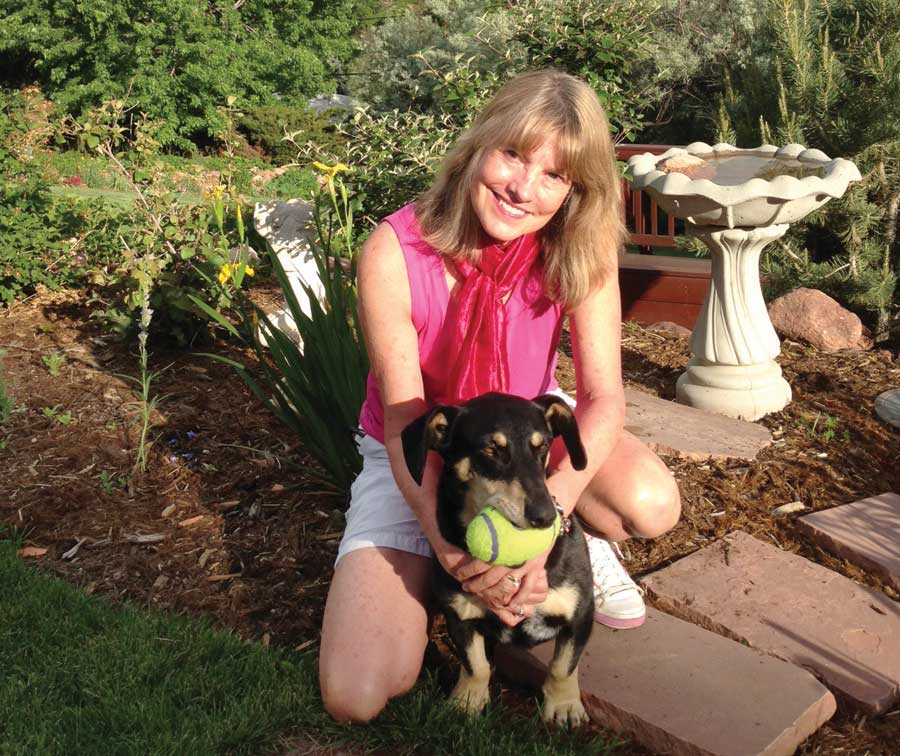Potting Spots
28 Jun 2015
A potting station can be a creative project that pays off in terms of gardening ease.
It’s hard not to covet the potting stations we see at nurseries, especially when we drive home with soil and flowers and ponder the project ahead: lugging pots and garden tools from the garage, mixing soil and compost, filling pots, digging holes, transplanting flowers. Then there’s sweeping up the dirt and putting away the tools. [pp_gallery gallery_id="11305" width="120" height="140"] Planting is a fun project, for sure, but a potting station can make it an easier one. The basic elements of any decent potting bench include a base, a work surface and shelves, says Connie Smith, manager of Boulder’s Sturtz & Copeland Florists, Greenhouses and Fine Stationery. You’ll also need storage for tools, pots and soil. You can buy prefab potting stations at gardening and hardware stores, or you can create your own. Sturtz hired local craftsmen to build its potting areas, but personal touches can make a home potting station look less utilitarian. To gather inspiration for her potting station, Canada-based landscape blogger Anne Davis (www.designdreamsbyanne) perused images in magazines and online. When it comes to the overall look, she says, “Don’t be afraid to use unconventional items.” She used a fireplace screen and a window for the backing of her potting station. Even an old door can gussy up a potting area, and it’s a no-brainer for shelving. To give your station texture, incorporate things like stained glass, mirrors, corrugated metal and even ceiling tiles. Wind chimes and art can add another dimension. For whi msy, mix tools with keepsakes and mementos that you can swap out if you feel like it. “The fun thing about a potting bench is it can hold a lot of unique items and be functional at the same time,” says longtime gardener Sue Langley. With a few decorative items and splashes of color, you can make a potting station an attractive garden element that you’ll use often and enjoy.
Potting stations can go just about anywhere, too. Perhaps against a fence, beside your house, beneath a tree, or freestanding in the yard. Just remember you’ll need afternoon shade and access to a garden hose. Davis used brick for her station’s base, but a dirt or gravel foundation would work well, too. Pine needles can help soften the standing area.
msy, mix tools with keepsakes and mementos that you can swap out if you feel like it. “The fun thing about a potting bench is it can hold a lot of unique items and be functional at the same time,” says longtime gardener Sue Langley. With a few decorative items and splashes of color, you can make a potting station an attractive garden element that you’ll use often and enjoy.
Potting stations can go just about anywhere, too. Perhaps against a fence, beside your house, beneath a tree, or freestanding in the yard. Just remember you’ll need afternoon shade and access to a garden hose. Davis used brick for her station’s base, but a dirt or gravel foundation would work well, too. Pine needles can help soften the standing area.
One Person’s Plan
Langley, who lives in the central California mountains, had a messy area outside a shed that needed clearing. She thought it might be the perfect spot for a potting station, so she posted a picture of the cluttered space on her website and asked how to transform it into a functional, yet stylish, potting spot. She started her website (www.flea marketgardening.com) as a forum for “real people, real gardens and real projects,” she says, and the ideas soon poured in. So did comments like, “It’s such a relief to see that somebody else has a messy area, too!”
Langley took a suggestion of making two piles from the clutter—one with keepers, the other with throwaways and recyclables. In the keep pile were pieces that meant something to her, like a cart her dad once wheeled around to collect dug-up weeds, and her Bauer flowerpots—collectible 1950s California pottery with jewel tones reminiscent of Fiestaware. She also kept a few discarded windows and shutters she’d found, along with a mailbox, terra-cotta pots, galvanized tubs, wooden crates and some wood that was lying around.
Throwaways and recyclables in--cluded broken things, plastic chairs and pots, and “a cute little snail planter that just didn’t fit into my style.”
Langley used the shed for her -potting-station’s backdrop, centering a workbench her husband built from reclaimed wood against the side. Then she secured a wooden window frame and shutters to the bench for decoration, and added wooden shelves on either side. “Shelves are important for storing pots and keeping my work surface clear,” she says.
She started her website (www.flea marketgardening.com) as a forum for “real people, real gardens and real projects,” she says, and the ideas soon poured in. So did comments like, “It’s such a relief to see that somebody else has a messy area, too!”
Langley took a suggestion of making two piles from the clutter—one with keepers, the other with throwaways and recyclables. In the keep pile were pieces that meant something to her, like a cart her dad once wheeled around to collect dug-up weeds, and her Bauer flowerpots—collectible 1950s California pottery with jewel tones reminiscent of Fiestaware. She also kept a few discarded windows and shutters she’d found, along with a mailbox, terra-cotta pots, galvanized tubs, wooden crates and some wood that was lying around.
Throwaways and recyclables in--cluded broken things, plastic chairs and pots, and “a cute little snail planter that just didn’t fit into my style.”
Langley used the shed for her -potting-station’s backdrop, centering a workbench her husband built from reclaimed wood against the side. Then she secured a wooden window frame and shutters to the bench for decoration, and added wooden shelves on either side. “Shelves are important for storing pots and keeping my work surface clear,” she says.
 The Bauer pots provided the color scheme, so she hung a few paintings with similar tones above the potting station, and put a stained-glass piece, a metal ring and a mirror on the shelves. She arranged the terra-cotta pots on a shelf in order of size, from small to large, to keep the area looking organized, and hid unsightly supplies in the lattice-screened area below the bench. (You could also use a curtain to the same effect.)
She put things she didn’t want the weather to affect, like gardening gloves and seed packets, inside the mailbox. “If you secure the mailbox to a post, it makes such a charming little dry--storage area,” she says.
Langley increased her workspace by placing a galvanized-steel sink to the right of the potting bench and attached rake prongs to the shed to hang hand-tools. A crock on the sink surface holds more tools—the “grab-and-go ones,” she says. “If I feel like stopping and heading into the garden to clip or water, I can grab my hand tools out of the crock and off I go.”
An antique Boraxo dispenser she bought on eBay hangs above the sink, and she plans to buy a special plumbing attachment for the found faucet so she can hook up a hose to rinse vegetables and other things. “I’ll just put a bucket beneath the sink to catch the water and then reuse it in the garden,” she says. She grows garlic and onions in two nearby galvanized tubs, which she also uses for starter plants and ones that need extra TLC.
With a little elbow grease, Langley turned a “mess” into a cute, rustic potting station that has everything within reach. “I can work on several pots at a time and get all my planting done in one spot,” she says. “It’s useful and functional.” And when she needs a break, a blue Adirondack chair sits nearby.
“It used to be an eyesore,” Langley says of her potting spot, “but now I’m so proud of it.”
The Bauer pots provided the color scheme, so she hung a few paintings with similar tones above the potting station, and put a stained-glass piece, a metal ring and a mirror on the shelves. She arranged the terra-cotta pots on a shelf in order of size, from small to large, to keep the area looking organized, and hid unsightly supplies in the lattice-screened area below the bench. (You could also use a curtain to the same effect.)
She put things she didn’t want the weather to affect, like gardening gloves and seed packets, inside the mailbox. “If you secure the mailbox to a post, it makes such a charming little dry--storage area,” she says.
Langley increased her workspace by placing a galvanized-steel sink to the right of the potting bench and attached rake prongs to the shed to hang hand-tools. A crock on the sink surface holds more tools—the “grab-and-go ones,” she says. “If I feel like stopping and heading into the garden to clip or water, I can grab my hand tools out of the crock and off I go.”
An antique Boraxo dispenser she bought on eBay hangs above the sink, and she plans to buy a special plumbing attachment for the found faucet so she can hook up a hose to rinse vegetables and other things. “I’ll just put a bucket beneath the sink to catch the water and then reuse it in the garden,” she says. She grows garlic and onions in two nearby galvanized tubs, which she also uses for starter plants and ones that need extra TLC.
With a little elbow grease, Langley turned a “mess” into a cute, rustic potting station that has everything within reach. “I can work on several pots at a time and get all my planting done in one spot,” she says. “It’s useful and functional.” And when she needs a break, a blue Adirondack chair sits nearby.
“It used to be an eyesore,” Langley says of her potting spot, “but now I’m so proud of it.”
By Ruthanne Johnson












